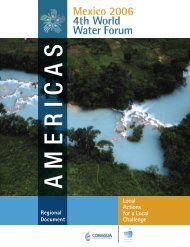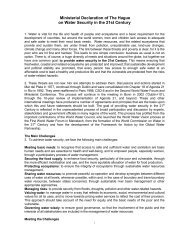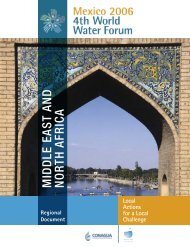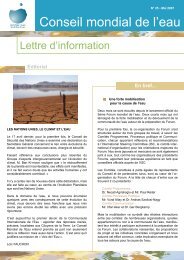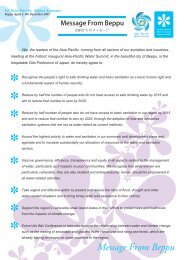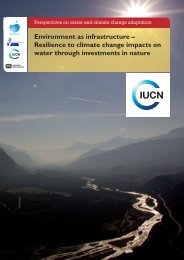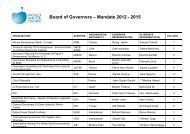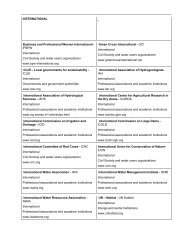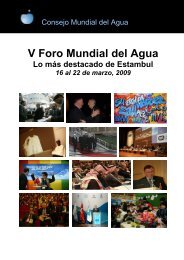the human right to water and sanitation in emergency situations
the human right to water and sanitation in emergency situations
the human right to water and sanitation in emergency situations
You also want an ePaper? Increase the reach of your titles
YUMPU automatically turns print PDFs into web optimized ePapers that Google loves.
Table of contents<br />
6.7. Responsibilities of ac<strong>to</strong>rs o<strong>the</strong>r than States ..................................................................................... 43<br />
6.8. What does General Comment 15 say about <strong>emergency</strong> <strong>situations</strong>? ............................................. 44<br />
Chapter 7 - Recognition <strong>in</strong> some <strong>human</strong> <strong>right</strong>s <strong>in</strong>struments targeted at specific groups:<br />
focus on women <strong>and</strong> children ................................................................................................................. 47<br />
Chapter 8 - Human <strong>right</strong>s obligations related <strong>to</strong> <strong>sanitation</strong> ............................................................... 49<br />
8.1. Recognition under Human <strong>right</strong>s <strong>in</strong>struments ................................................................................. 49<br />
8.2. Impetus given by <strong>the</strong> International Year of Sanitation (IYS) .............................................................. 50<br />
Chapter 9 - Developments at <strong>the</strong> Human Rights Council .................................................................. 53<br />
Chapter 10 - The <strong>human</strong> <strong>right</strong> <strong>to</strong> <strong>water</strong> <strong>and</strong> <strong>sanitation</strong> <strong>in</strong> <strong>situations</strong> of armed conflict:<br />
<strong>the</strong> legal framework .................................................................................................................................. 57<br />
10.1. Key message ................................................................................................................................. 57<br />
10.2. Background ................................................................................................................................... 57<br />
10.3. Protection of fresh <strong>water</strong> <strong>in</strong> time of armed conflict ........................................................................ 58<br />
10.4. Is it a war crime <strong>to</strong> attack a population’s <strong>water</strong> supply? ................................................................ 62<br />
10.5. Conclusion ..................................................................................................................................... 64<br />
Chapter 11 - The <strong>right</strong> <strong>to</strong> <strong>water</strong> <strong>and</strong> <strong>sanitation</strong> <strong>in</strong> national legislation .............................................. 65<br />
Chapter 12 - operational guidel<strong>in</strong>es apply<strong>in</strong>g <strong>in</strong> <strong>emergency</strong> <strong>situations</strong> <strong>and</strong> <strong>the</strong> <strong>human</strong><br />
<strong>right</strong> <strong>to</strong> <strong>water</strong> <strong>and</strong> <strong>sanitation</strong> .................................................................................................................... 69<br />
12.1. Key message ................................................................................................................................. 69<br />
12.2. How is <strong>the</strong> <strong>human</strong> <strong>right</strong> <strong>to</strong> <strong>water</strong> <strong>in</strong>cluded <strong>in</strong> <strong>the</strong> Sphere St<strong>and</strong>ards? ........................................... 69<br />
12.3. How is <strong>the</strong> <strong>human</strong> <strong>right</strong> <strong>to</strong> <strong>water</strong> <strong>and</strong> <strong>sanitation</strong> <strong>in</strong>cluded <strong>in</strong> <strong>the</strong><br />
Operational Guidel<strong>in</strong>es on Human Rights <strong>and</strong> Natural Disasters? ......................................................... 72<br />
12.4. Conclusion ..................................................................................................................................... 74<br />
PART 3 - ADVoCACY on THE RIGHT To WATER AnD SAnITATIon In EMERGEnCIES ........... 75<br />
Chapter 13 - The pr<strong>in</strong>ciples of advocacy on <strong>the</strong> <strong>right</strong> <strong>to</strong> <strong>water</strong> <strong>and</strong> <strong>sanitation</strong> ............................... 76<br />
13.1. Key message ................................................................................................................................. 76<br />
13.2. What exactly is advocacy <strong>in</strong> emergencies? ................................................................................... 76<br />
13.3. Added value of <strong>right</strong>s-based advocacy <strong>in</strong> emergencies................................................................ 77<br />
13.4. Opportunities offered by a <strong>right</strong>s-based approach <strong>to</strong> advocacy ................................................... 80<br />
13.5. Key challenges <strong>to</strong> <strong>right</strong>s-based <strong>water</strong>-related advocacy ............................................................... 81<br />
Chapter 14 - Design<strong>in</strong>g <strong>and</strong> implement<strong>in</strong>g advocacy action on <strong>the</strong> <strong>right</strong> <strong>to</strong> <strong>water</strong><br />
<strong>in</strong> emergencies ........................................................................................................................................... 83<br />
14.1. General pr<strong>in</strong>ciples <strong>in</strong> respect of <strong>the</strong> identification of violations of economic, social <strong>and</strong><br />
cultural <strong>right</strong>s............................................................................................................................................ 83<br />
14.2. Identify<strong>in</strong>g violations of <strong>the</strong> <strong>right</strong> <strong>to</strong> <strong>water</strong> ....................................................................................... 84<br />
14.3. What types of advocacy should be undertaken <strong>in</strong> support of <strong>the</strong> <strong>right</strong> <strong>to</strong> <strong>water</strong> <strong>and</strong> <strong>sanitation</strong>? ..... 95<br />
14.4. Develop<strong>in</strong>g an advocacy strategy ............................................................................................... 103<br />
14.5. Conclusion .................................................................................................................................. 103<br />
AnnEXES .............................................................................................................................................. 107<br />
Annexe 1 30 years of WASH <strong>in</strong>ternational political progress <strong>in</strong> brief ....................................................... 108<br />
Annexe 2 Orig<strong>in</strong> of <strong>the</strong> General Comment 15 .......................................................................................... 112<br />
Annexe 3 Summary of <strong>the</strong> key <strong>in</strong>ternational <strong>human</strong> <strong>right</strong>s <strong>in</strong>struments<br />
of law that are relevant <strong>to</strong> <strong>the</strong> <strong>right</strong> <strong>to</strong> <strong>water</strong> ............................................................................. 113<br />
Annexe 4 Key extracts from <strong>the</strong> Geneva Conventions <strong>and</strong> <strong>the</strong> two Additional Pro<strong>to</strong>cols<br />
that are relevant for <strong>water</strong> protection ....................................................................................... 116<br />
Annexe 5 Some common misunderst<strong>and</strong><strong>in</strong>gs about <strong>the</strong> <strong>right</strong> <strong>to</strong> <strong>water</strong> <strong>and</strong> <strong>sanitation</strong> .......................... 118<br />
BIBLIoGRAPHY ...................................................................................................................................... 119<br />
© ACF - THE HUMAN RIGHT TO WATER AND SANITATION IN EMERGENCY SITUATIONS<br />
7



